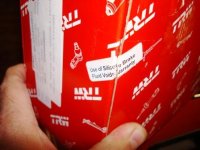dklawson
Yoda
Offline
I just received a new brake master cylinder for our project '72 Spitfire. It arrived in a TRW box with a statement/decal on the outside warning that the use of Silicone brake fluid would void the warranty.
I discussed this with the supplier and they told me that there have been issues with the compatibility of the fluid with the seals due to surface finishes and the DOT-5 fluid not providing enough lubrication. They suggested several problems that might arise from this.
I'm still considering using DOT-5 as I've used it with success (and no problems at all) in both my Mini and our GT6. Has anyone out there experienced seal problem with master cylinders when using DOT-5?
I discussed this with the supplier and they told me that there have been issues with the compatibility of the fluid with the seals due to surface finishes and the DOT-5 fluid not providing enough lubrication. They suggested several problems that might arise from this.
I'm still considering using DOT-5 as I've used it with success (and no problems at all) in both my Mini and our GT6. Has anyone out there experienced seal problem with master cylinders when using DOT-5?

 Hey there Guest!
Hey there Guest!
 smilie in place of the real @
smilie in place of the real @
 Pretty Please - add it to our Events forum(s) and add to the calendar! >>
Pretty Please - add it to our Events forum(s) and add to the calendar! >> 


 A friendly reminder - be careful what links you click on here. If a link is posted by someone you don't know, or the URL looks fishy, DON'T CLICK. Spammers sometimes post links that lead to sites that can infect your computer, so be mindful what you click.
A friendly reminder - be careful what links you click on here. If a link is posted by someone you don't know, or the URL looks fishy, DON'T CLICK. Spammers sometimes post links that lead to sites that can infect your computer, so be mindful what you click.